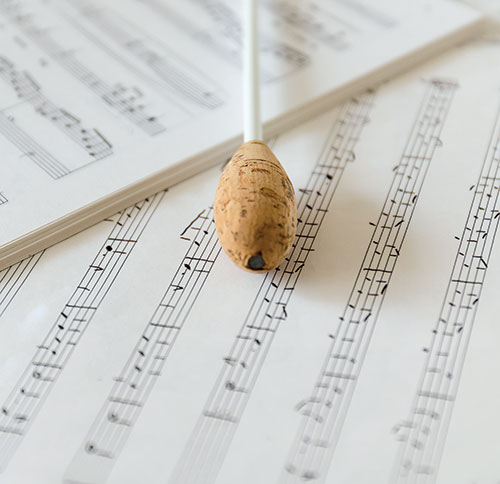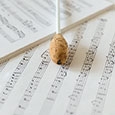
Conductors must know the score before stepping on the podium. As part of my dissertation at The Ohio State University, I interviewed college professors, freelance composers, community band conductors, and graduate students who considered themselves composers and conductors. One of the themes of the interviews was that all 16 composer/
conductors stated that composing improved their score study, interpretation, and artistic expression when preparing music by other composers. Below are some of the great perspectives and lessons learned that every conductor might consider when preparing for score study.
As Gunther Schuller says in his book The Compleat Conductor, “It is a conductor’s job to understand the process by which a thousand and one such ‘inevitable’ choices are made by the composer and, as I say, to retrace those steps of creation, to recreate in his conducting that decisional process, not in some merely mechanical rendering but in a manner that is emotionally, expressively inspired by that process.”
Timothy Mahr, Director of Bands at St. Olaf College teaches a workshop called Some Thoughts on Score Study from the Composer’s Perspective. Mahr explains, “One of the things that I do is start with a blank staff on a chalkboard or whiteboard. Then I’ll make a circular note head and I tell [the students] ‘Every time I make a mark, listen internally. I want you to hear what I’m writing.’ I’ll go through filling in the note head, adding a stem, putting a dot on the note head, putting an accent over it, tying it to another note, if it’s a sixteenth note, making it a fortepiano, crescendo up to forte, slow release, little markings on it, I write in adagio then I put it in alto clef. You know, because most of them were hearing it in their home clef.
“By the time I’m all done, it’s usually about 15 to 18 markings that have spots that define one little moment, and because I use alto clef, I joke with it a bit and say, ‘Now imagine that I’ve given each of you a viola and then [asked] each one of you to play that. Each one of you will make a different sound. And that’s just one moment in a piece of music. Imagine if this were a moment within a Mahler symphony or something like that.”
As a composer, Mahr knows what it is like to make those choices in his music. This perspective allows him to shine a light on an important aspect of score study that can be easily overlooked: when conductors study scores, it is important to look at each detail, not only as a marking on a page, but as an important decision made by the composer – a decision to be treated with care, as it all feeds in to the feeling and intention of the work.
Andrew Boysen, Director of Bands at the University of New Hampshire is conservative in his interpretation of other composers’ scores. “I’m not a big fan of people changing stuff. I’ve heard people say ‘As a conductor I want to put my stamp on it.’ . . . I have only rarely been upset about what people did to my music, if they changed stuff, or just added stuff in that was clearly not there. . . . It did seem like there was a time when a lot of the military bands [had a philosophy that] if it wasn’t on the page, they weren’t doing it, and what often results from this is a flat performance.
“If I’m working on Mozart’s Serenade with my grad students, and they add a little ritard right before the recap, I’m going to say that’s not there, so let’s not do it. They might respond, ‘It’s the recap; I wanted to draw attention to what is happening in the form.’ I would have no problem with that whatsoever. So, if there is a reason [a performer] thinks the composer might have wanted something, if that is expressing the piece, I think there is room for that, but I don’t think that should be about the performer.”
Paul Brust, Professor of Composition at The Longy School of Music of Bard College, is more practical in his approach to score interpretation, operating under the assumption that the score was the final version of what the composer wanted.
During my Master’s studies at the Longy School of Music, Brust once conducted a reading session of one of my pieces for the Pierrot ensemble. At the time, I was purposely ambiguous with my tempo markings to give conductors room for interpretation. Before a rehearsal Brust came to me inquiring exactly how fast I wanted a particular section to go. The score was marked Allegro, but he pointed out that Allegro could really mean anything from 118-140 beats per minute. At the time of the conversation he pointed out that he did not know my music and therefore did not have enough knowledge or information to decide on the tempo.
Gene Pollart, Director of Bands at the University of Rhode Island uses a more liberal approach. “If you are playing a Bach piece it should say Bach, followed by whoever the conductor is because [conductors are] creating an interpretation.” As an example, Pollart mentioned the well-known 6/4 section from Alfred Reed’s Russian Christmas Music, saying, “I conduct it in two instead of in six because I want it to move along. I’m not sure that Alfred Reed intended it that way, but that’s how I feel, so it works. If it didn’t work, that would be another thing.”
In contrast to how the interviewees felt about interpreting other composers’ music, they all had a liberal attitude about the interpretative choices other conductors made about of their own music. Jason Taurins, High School Band Director from Rio Rico Arizona commented, “I don’t think you have to be a micromanager as a composer. Some composers tend to micromanage, working every little bit of detail they can into their scores. That makes it easier to interpret their music, because so much of what they want is detailed right on the page. However, I tend to do that last and leave more up to the performer or conductor.”
Another theme I identified was the value of practicality when making decisions about the music. Lewis J. Buckley, retired Director of the United States Coast Guard Band said, “My first effort is always to believe what the composer wanted. For example, I don’t screw around with tempos right off the bat. My first step will be to try to make it work the way I think the composer wanted it to work based on what I can see. Having said that, if it doesn’t work for me or the group, I do not hesitate at all to change tempos or interpretations. I’ve seen so many composers, including great ones [like] Aaron Copland and Igor Stravinsky, conducting their music at completely different tempos than what they put in the score.”
Boysen values having knowledge of the time period, style of the piece, harmonic structure, and more to allow conductors to make interpretive decisions about the piece. “Every version of a piece is going to sound different depending on who conducted it, the size of the ensemble, how they approach the music, and if someone is going to mess with it just to mess with it.”
Mahr considers it a matter of integrity to study the score and about the composer before making an artistic decision about interpretative ideas. Regardless of how much notation is in the score, if one studies it well and takes the time to learn about the period, composer, and ideas behind the piece, their intuition will help guide the decisions about how to interpret the piece.
When we compose, we build music bit by bit and then dissect what we’ve done, and revise our work. Thus, we know what to look for and where to look in others’ music. As Boysen put it, “While you are composing you are deep into your piece. If I could get my score study to the point where I felt like I was composing, that would be ideal.” Taurins echoed this, saying, “When I’m studying another person’s score, I try to get into the composer’s mind and think about what they are thinking.”
Erika Svanoe, Director of Bands at Augsburg University in Minneapolis, feels that being a composer gives her greater confidence about interpretive decisions for others’ works. “I spent a summer digging into Holst’s First Suite, looking at every chord of that Chaconne movement. I feel solid in my interpretation when I feel like have really deep understanding of that music and I feel confident in my musical choices as a conductor because of that.”
After my interviews, it was clear how much each composer/conductor’s experiences in the creative process has influenced and improved not only how they conduct their works, but also how they conduct others’ works. Whether it is an arrangement, a simple composition for your instrument, or a new work you wrote, delving into how the music comes together will give you a greater understanding and a more intimate perspective when you study scores and step onto the podium.






